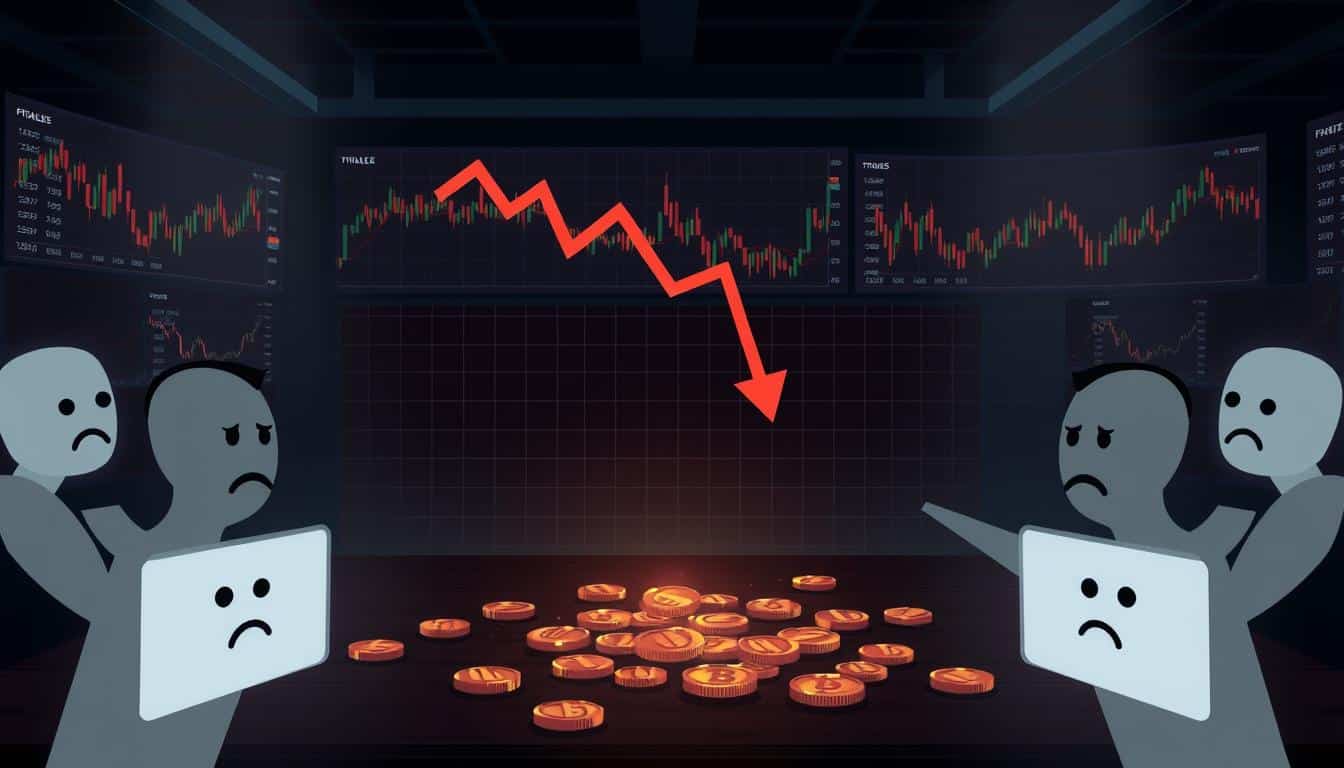The crypto market took a hit with $209 million liquidated in 24 hours. This marks October’s second-largest liquidation day1. The sudden dip affected 63,004 traders, causing significant losses1.
Bitcoin felt the sting with $56.67 million in positions wiped out. Ethereum followed close behind, losing $47.61 million1. Long positions suffered the most, accounting for $131 million of total liquidations.
Short positions saw $76.74 million in losses1. The largest single hit was a $5.3 million wipeout on HTX’s BTC-USDT pair. This event highlights the crypto market’s ongoing volatility1.
Key Takeaways
- $209 million in crypto liquidations occurred in 24 hours
- Bitcoin saw $56.67 million in liquidations
- Ethereum experienced $47.61 million in liquidations
- 63,004 traders were affected by the market dip
- Long positions accounted for $131 million of total liquidations
- The largest single liquidation was $5.3 million on HTX’s BTC-USDT pair
Understanding the Recent Bitcoin Price Dip
Bitcoin’s value has recently dropped, shaking up the cryptocurrency market. This dip has affected both big and small players in the industry. Investors and analysts are closely watching these price changes.
Factors Contributing to the Price Decrease
Several factors have caused Bitcoin’s recent price drop. The rising U.S. dollar has impacted global markets and cryptocurrencies2.
Japan’s political instability and expected delays in rate hikes have also swayed market sentiment3. These events have contributed to the overall decline in Bitcoin’s value.
Impact on the Broader Cryptocurrency Market
Bitcoin’s price swings have affected the entire cryptocurrency market. As Bitcoin’s value fell, many altcoins followed suit. This trend shows Bitcoin’s ongoing influence in the crypto world.
| Asset | Price Change | Market Cap Impact |
|---|---|---|
| Bitcoin | -5.2% | -$52 billion |
| Ethereum | -4.8% | -$18 billion |
| Altcoins (avg) | -6.5% | -$30 billion |
Historical Context of Bitcoin Price Fluctuations
Bitcoin’s price history is full of ups and downs. The current dip is similar to past market corrections. These drops often come before growth periods.
While the S&P 500 fell 1% last week, crypto markets usually have bigger price swings3. This difference highlights the unique nature of cryptocurrency investments.
The crypto market keeps changing. U.S. tech giants’ earnings reports and job data will likely affect Bitcoin’s price soon3.
Investors should stay informed about these market shifts. It’s important to view these changes as part of long-term trends in the crypto world.
Analyzing the Massive Liquidation Event
A major shake-up hit the crypto market, causing a huge liquidation event. Let’s explore its scope and impact on trading positions.
Total Value of Liquidations
The crypto market saw $209 million in liquidations within 24 hours. This shows the market’s extreme volatility and its effect on traders.
Bitcoin led with $56.67 million in liquidations. Ethereum followed close behind with $47.61 million liquidated.
Long vs. Short Positions
Long positions took the biggest hit, accounting for $131 million of total liquidations. Short positions totaled $76.74 million in comparison.
This gap shows the risks of leveraged trading in unstable markets. Traders should be cautious when using leverage.
| Position Type | Liquidation Value (USD) | Percentage of Total |
|---|---|---|
| Long | $131 million | 63.07% |
| Short | $76.74 million | 36.93% |
| Total | $209 million | 100% |
October’s Liquidation Events
This event is October’s second-largest liquidation, highlighting the month’s market instability. It reminds us of the risks in crypto trading during uncertain times.
Liquidations can signal potential market changes. Investors might consider PropiChain for AI-driven insights into smarter investments4.
Understanding liquidating dividends can help interpret market events. These are treated as a return of capital, not income5.
Bitcoin’s Market Dominance and Its Effect on Altcoins
Bitcoin’s market dominance shapes the cryptocurrency landscape. It holds a 59.31% market share, nearing the 60% threshold6. This dominance greatly affects altcoins and market dynamics.
As Bitcoin’s dominance rises, altcoins often slow down. Experts predict weaker returns for altcoin seasons in future cycles6. This shift could reduce altcoin gains over time.
The Bitcoin-altcoin relationship is complex. Some say 60% Bitcoin dominance might boost altcoins6. Others warn against long bets on altcoins, calling it an “insiders game.”
Currently, “memecoins” are popular in the altcoin space. They’re often seen as a joke in crypto6. This trend shows how unpredictable altcoin markets can be.
Experts think a true altcoin season may start when Bitcoin tops $80,0006. Bitcoin could reach $500,000, driven by institutional investments. This growth might reshape the crypto market7.
Flash Bitcoin trading on Coinbase, Binance, and Kraken offers quick profit chances8. These fast trades match the speedy crypto market pace.
Understanding Bitcoin’s dominance is key for crypto investors. It helps navigate the ever-changing market cycles.
The Role of Institutional Investors in the Current Market
Institutional investors are changing the cryptocurrency landscape, especially with Bitcoin ETFs. They bring massive financial resources and expert market analysis to crypto. Their involvement is reshaping how the market operates.
Institutional Participation in Bitcoin ETFs
Bitcoin ETFs have created new opportunities for institutional investors. Big players like BlackRock are buying large amounts of Bitcoin. This influx of institutional money is pushing the market upward.
These investments are altering the way cryptocurrency trading works. The market is becoming more sophisticated and potentially more stable.
Impact of Institutional Buying and Selling Patterns
Institutional investors’ trading strategies greatly affect market movements. Their large-scale trades can cause ripples across the entire crypto ecosystem. The F&O market helps these investors trade efficiently9.
This market provides liquidity for their entry and exit strategies. It allows for smoother transactions of large quantities.
| Aspect | Impact |
|---|---|
| Market Liquidity | Increased due to institutional trading |
| Price Volatility | Potentially reduced with larger market participants |
| Market Depth | Enhanced, allowing for larger trades |
Future Outlook for Institutional Involvement in Crypto
The future of institutional involvement in crypto looks bright. As regulations improve and markets mature, more traditional financial institutions may join. This could lead to greater market stability.
It might also drive long-term growth in the cryptocurrency sector. Despite market ups and downs, institutional investors remain interested.
Their continued involvement could help create a more mature crypto ecosystem. This may bring positive changes to the market in the coming years.
Technical Analysis of Bitcoin’s Price Action
Bitcoin’s price action has been turbulent, causing market unrest. The second-largest liquidation day in October hit crypto bulls hard. This volatility has drawn attention to key support and resistance levels.
Analysts are studying volume profiles to grasp the market’s macro-level context. They’ve pinpointed $69,000 and $70,200 as critical points for potential price reversals. These levels are crucial for traders aiming to profit from Bitcoin’s movements.
Bearish divergences on the 10-hour chart support a downward trend. Some experts predict a possible drop to $64,500. Despite this, Bitcoin and Ethereum still have higher success probabilities in the crypto market.
“In trading, discipline is key. Don’t chase trades; wait for the right setup.”
Staying informed is vital in this unpredictable market. Find valuable insights on cryptocurrency investment strategies to guide your decisions.
| Price Level | Significance | Trader Action |
|---|---|---|
| $70,200 | Major Resistance | Potential Sell Zone |
| $69,000 | Secondary Resistance | Watch for Reversal |
| Current Price | Consolidation | Monitor Support |
| $64,500 | Predicted Support | Potential Buy Zone |
Technical analysis offers valuable insights for traders. However, it’s best to combine it with fundamental analysis. Keep an eye on market sentiment for a well-rounded trading strategy10.
Market Sentiment and Investor Psychology
Investor sentiment and market psychology heavily sway the cryptocurrency market. Price fluctuations make understanding these factors vital for traders and investors. Grasping these elements can help navigate the crypto landscape more effectively.
Fear and Greed Index Analysis
The Fear and Greed Index measures crypto market sentiment. Recent price dips have pushed the index towards extreme fear. This shift often signals potential buying opportunities for contrarian investors.
These investors view market fear as a sign of oversold conditions. They might see it as a chance to invest at lower prices.
Social Media Reactions
Social media platforms significantly impact market sentiment. Twitter trends and Reddit forums buzz with reactions to price movements. During dips, some users express panic, while others see buying opportunities.
This social media activity highlights crowd psychology’s role in market dynamics. It shows how online discussions can influence investor behavior.
Expert Opinions on Market Direction
Analysts and industry experts offer diverse views on the market’s future. Some highlight fundamental strengths and growing adoption as reasons for optimism. Others warn about potential regulatory challenges and market volatility.
These expert opinions shape overall market psychology. They influence investor decisions and sentiment, adding to the market’s complexity.
| Sentiment Indicator | Current Reading | Market Implication |
|---|---|---|
| Fear and Greed Index | Extreme Fear | Potential buying opportunity |
| Social Media Sentiment | Mixed | Uncertainty in market direction |
| Expert Consensus | Cautiously Optimistic | Long-term growth potential with short-term volatility |
Grasping market sentiment and investor psychology offers valuable insights for crypto investing. It helps investors make informed decisions in this dynamic market. These factors play a crucial role in shaping the cryptocurrency landscape11.
Bitcoin ETFs and Their Impact on the Market
Bitcoin ETFs are changing how people invest in cryptocurrency. These funds let you indirectly own Bitcoin by buying shares. The SEC recently approved options trading for spot Bitcoin ETFs on various exchanges12.
The market’s reaction has been strong. Since October 11, $3.3 billion has flowed into spot Bitcoin ETFs. This averages $327 million per day across 10 trading days12.
Surprisingly, 80% of the $21.6 billion in ETF inflows came from everyday investors. This shows widespread interest in Bitcoin investments12.
Bitcoin ETFs now hold over 938,000 BTC, worth $63.3 billion. This represents 4.5% of all Bitcoin in circulation13. Including similar funds, the total reaches 1.1 million BTC, about 5.2% of supply13.
The approval of options trading on Bitcoin ETFs brings benefits to investors. It offers hedging options, better liquidity, and reduced volatility12. This move is expected to attract more institutional and retail investors12.
| ETF Provider | Market Share | Notable Features |
|---|---|---|
| BlackRock’s IBIT | Significant portion of net inflows | Part of top 3 ETFs |
| Grayscale’s GBTC | Part of 84% total market | Converted from trust to ETF |
| Fidelity’s FBTC | Part of 84% total market | Strong brand recognition |
Three main players dominate the Bitcoin ETF market. BlackRock’s IBIT, Grayscale’s GBTC, and Fidelity’s FBTC make up about 84% of the total market13.
Institutional interest in Bitcoin ETFs is growing. Investors are becoming more comfortable with digital assets. This is partly due to Bitcoin’s increasing correlation with the S&P 50013.
Regulatory Developments Affecting Cryptocurrency Markets
The global regulatory landscape for cryptocurrencies is changing fast. These changes have big effects on investors and traders. They show how complex the relationship is between new ideas and rules in crypto.
Recent Regulatory Announcements and Their Impact
Big companies like BlackRock, Fidelity, and JPMorgan are getting into cryptocurrencies14. This is changing the market in important ways. Many governments are also looking into making their own digital money called CBDCs14.
These CBDCs could have a big impact on how cryptocurrencies work. They might change how people use and think about digital money.
Global Regulatory Landscape for Cryptocurrencies
The total value of all cryptocurrencies is now $2,301,400,000,00015. This shows how important crypto has become. In South Africa, officials are making new rules for cryptocurrencies16.
They want to help new ideas grow while also keeping people safe. Many countries are trying to do the same thing with their crypto rules.
Potential Future Regulatory Changes
In the future, there might be more rules about watching and reporting on cryptocurrencies. People are talking about how some cryptocurrencies use a lot of energy14.
This could lead to new rules that favor types of crypto that use less energy. As more people use crypto for everyday things and digital art, rules will need to change14.









